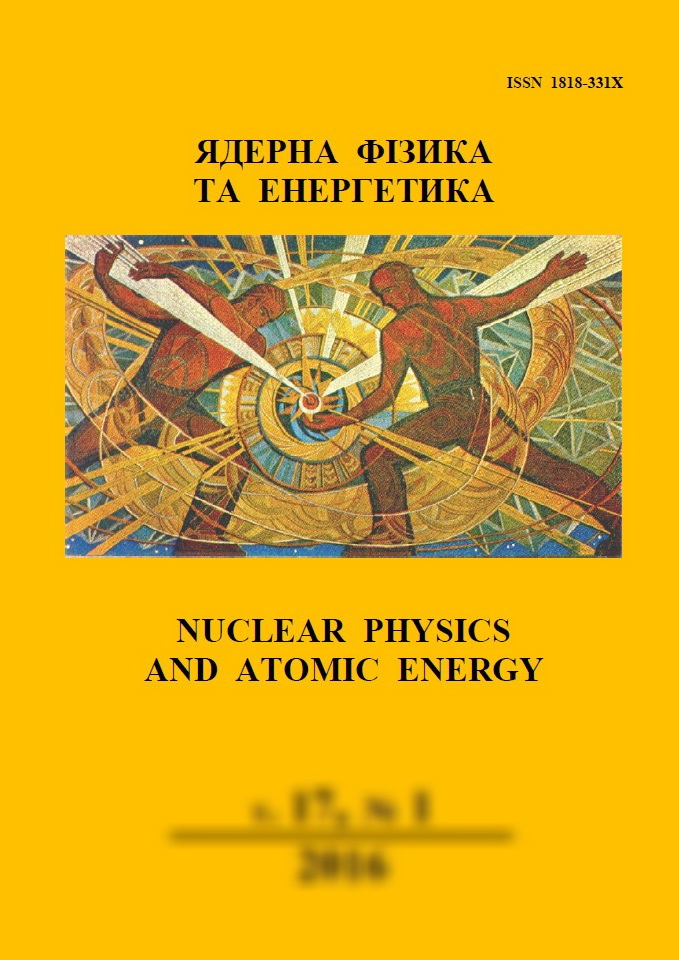 |
Ядерна фізика та енергетика
Nuclear Physics and Atomic Energy
ISSN:
1818-331X (Print), 2074-0565 (Online)
Publisher:
Institute for Nuclear Research of the National Academy of Sciences of Ukraine
Languages:
Ukrainian, English, Russian
Periodicity:
4 times per year
Open access peer reviewed journal
|
Nucl. Phys. At. Energy 2017, volume 18, issue 3, pages 245-253.
Section: Nuclear Physics.
Received: 01.06.2017; Accepted: 12.10.2017; Published online: 28.12.2017.
 Full text (ua)
Full text (ua)
https://doi.org/10.15407/jnpae2017.03.245
Design, commissioning and first measurements at the LEETECH spectrometer
D. Attie1, S. Barsuk2, O. Bezshyyko3, L. Burmistrov1, A. Chaus1, P. Colas1, O. Fedorchuk3, L. Golinka-Bezshyyko3, *, I. Kadenko3, V. Krylov2,3, V. Kubytskyi2, R. Lopez4, H. Monard2, V. Rodin3, M. Titov1, D. Tomassini4, A. Variola2
1 Commissariat of Nuclear and Alternative Energy, Institute for the Study of Fundamental Laws of Physics (CEA IRFU), Saclay, France
2 Linear Accelerator Laboratory (LAL), Orsay, France
3 Kyiv National Taras Shevchenko University, Kyiv, Ukraine
4 European Center for Nuclear Research, Geneva, Switzerland
*Corresponding author. E-mail address:
lyalka@univ.kiev.ua;
lyalkagb@gmail.com
Abstract:
The LEETECH (Low Energy Electron TECHnique) electron test beam facility has been designed and manufactured at Laboratoire de l’Accelerateur Lineaire (Orsay, France). Energy of electron beam can vary from 100 keV to 5 MeV. Two measurement sessions with application of the diamond sensor and the Micromegas/InGrid tracking module characterization were performed. Complete facility design with the Geant4 simulation, mechanical design, implementation of remote control and readout system is presented. An option to generate the electron bunches including a few particles only is confirmed, the obtained results are in rather good agreement with the corresponding simulation within uncertainty. Main results with the preliminary analysis from the Micromegas/InGrid measurement session are also presented.
Keywords:
Micromegas, InGrid, PHIL photoinjector, test beams, diamond detector, Micromegas/InGrid.
References:
1. D. Attie et al. LEETECH facility as a flexible source of low energy electrons. Yaderna Fizyka ta Energetyka (Nucl. Phys. At. Energy) 16(4) (2015) 337.
https://jnpae.kinr.kyiv.ua/16.4/Articles_PDF/jnpae-2015-16-0337-Attie.pdf
2. R. Roux et al. PHIL: a test beamline at LAL. Proc. of EPAC’08, Genoa, Italy, June 23 - 28, 2008. WEPP078. p. 2698.
3. I.-M. Gregor. Test beam for Detector Qualification in HEP. INFIERI'2013. School talk (2013) 8.
4. W. Matz et al. ROBL - a CRG Beamline for Radiochemistry and Materials Research at the ESRF. Journal of Synchrotron Radiation 6 (1999) 1076.
http://doi.org/10.1107/S0909049599010663
5. L. Quintieri et al. Photo-Neutron Source by High Energy Electrons on Target: Comparison between Monte Carlo Predictions and Experimental Measurements. IEEE Nuclear Science Symposium Conference Record 31(1) (2010) 915.
http://doi.org/10.1109/NSSMIC.2010.5873895
6. B. Buonomo et al. A wide range electrons, photons, neutrons beam facility. Proc. of EPAC’08, Genoa, Italy, June 23 - 28, 2008. THPC143. p. 3321.
7. S. Agostinelli et al. Geant4 - A Simulation Toolkit. Nuclear Instruments and Methods A 506 (2003) 250.
https://doi.org/10.1016/S0168-9002(03)01368-8
8. L. Ran et al. Design method of CAN BUS network communication structure for electric vehicle. International Forum on Strategic Technology (IFOST). (Ulsan, South Korea, 13 - 15 Oct. 2010) 326.
https://doi.org/10.1109/IFOST.2010.5668017
9. D. Breton et al. Using ultra fast analog memories for fast photodetector readout. Nuclear Instruments and Methods in Physics Research A 695 (2012) 61.
https://doi.org/10.1016/j.nima.2011.12.007
10. V. Kubytskyi et al. Study of low multiplicity electron source LEETECH with diamond detector. Journal of Instrumentation 12 (2017) P02011.
https://doi.org/10.1088/1748-0221/12/02/P02011
11. F. Sauli. GEM: A new concept for electron amplification in gas detectors. Nuclear Instruments and Methods in Physics Research A 386(2-3) (1997) 531.
https://doi.org/10.1016/S0168-9002(96)01172-2
12. Y. Giomataris et al. MICROMEGAS: a high-granularity position-sensitive gaseous detector for high particle-flux environments. Nuclear Instruments and Methods in Physics Research A 376(1) (1996) 29.
https://doi.org/10.1016/0168-9002(96)00175-1
13. M. Chefdeville et al. An electron-multiplying ‘Micromegas’ grid made in silicon wafer post-processing technology. Nuclear Instruments and Methods in Physics Research A 556(2) (2006) 490.
https://doi.org/10.1016/j.nima.2005.11.065
14. R. Diener et al. Development of a TPC for an ILC Detector. Physics Procedia 37 (2012) 456.
https://doi.org/10.1016/j.phpro.2012.02.393
15. M. Lupberger. The Pixel-TPC: A feasibility study. IEEE Nuclear Science Symposium and Medical Imaging Conference (San Diego, California, USA, 31 Oct. - 7 Nov., 2015) 141.
https://doi.org/10.1109/NSSMIC.2015.7581777
16. S.M. Seltzer, M.J. Berger. Improved procedure for calculating the collision stopping power of elements and compounds for electrons and positrons. The International Journal of Applied Radiation and Isotopes 35(7) (1984) 665.
https://doi.org/10.1016/0020-708X(84)90113-3
17. R.O. Duda, P.E. Hart. Use of the Hough transformation to detect lines and curves in pictures. Communications of the ACM 15(1) (1972) 11.
https://doi.org/10.1145/361237.361242
